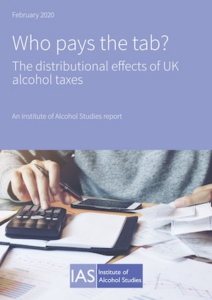View this report

Alcohol tax is widely recognised as one of the most important instruments governments have to address harmful drinking. Yet increases in duty are often resisted because of concerns that they are regressive and will therefore exacerbate inequalities.
It is unclear from the existing evidence how well-founded such fears are in the UK. Poorer households drink less alcohol on average. Yet surveys suggest that lower income households spend a greater share of their incomes on alcohol. On the other hand, surveys also find that alcohol accounts for a smaller share of the expenditure of lower spending households. This raises the question of whether income or expenditure is a better indicator of a household’s economic circumstances. We find both have limitations, but expenditure appears to be somewhat more reliable because of consistent under-reporting of income in official surveys.
In this report, we build on previous studies by directly estimating how much alcohol tax different households pay (rather than using total spending on alcohol as a proxy). Recognising that no indicator of affluence is perfect, we compare alcohol tax burdens across a range of measures: income, expenditure, occupational class, housing size and tenure and car ownership.
Overall, we find little difference between better-off and worse-off households in terms of the share of their income or expenditure accounted for by alcohol duty – at worst alcohol duty is only mildly regressive:
- The very richest 10-20% do pay proportionately less
- The bottom 10% may pay proportionately slightly more, but it is difficult to be certain because of data limitations
However, this varies between different alcohol taxes because of differences in drink preferences:
- Wine duty is clearly progressive
- Beer, cider and particularly spirits duty appear somewhat regressive
In any case, there are three factors that may mitigate the regressivity of any increase in alcohol duty:
- If poorer households are more price sensitive, this means that they will pay less of any increase in alcohol duty
- If the revenue from alcohol duty is used to fund progressive government spending or tax cuts, this will almost certainly offset any negative effect on inequality
- Economically disadvantaged households will see more of the health benefits of higher alcohol duty
Recognising previous analysis has overwhelmingly focused on the impact of alcohol duty on economic rather than social groups, we also looked at how its impact varies by gender, age and region, based on their consumption preferences:
- Overall, women pay significantly less alcohol duty than men – drinks consumed by women account for around two fifths of all alcohol duty
- Yet this varies substantially by product – men pay the vast bulk of beer and cider duty, women pay the majority of wine duty
- Wine duty also has greatest impact on middle aged drinkers, whereas beer, spirits and cider duty are more likely to be paid by younger drinkers
- Households in the North and Midlands pay proportionately more in beer duty, whereas households in Scotland spend the most on spirits duty
As with any fiscal policy, it is important to understand the distributional effects of alcohol duty. Based on the evidence we present here, we find little reason to avoid duty increases out of a concern for inequality.
View this report
